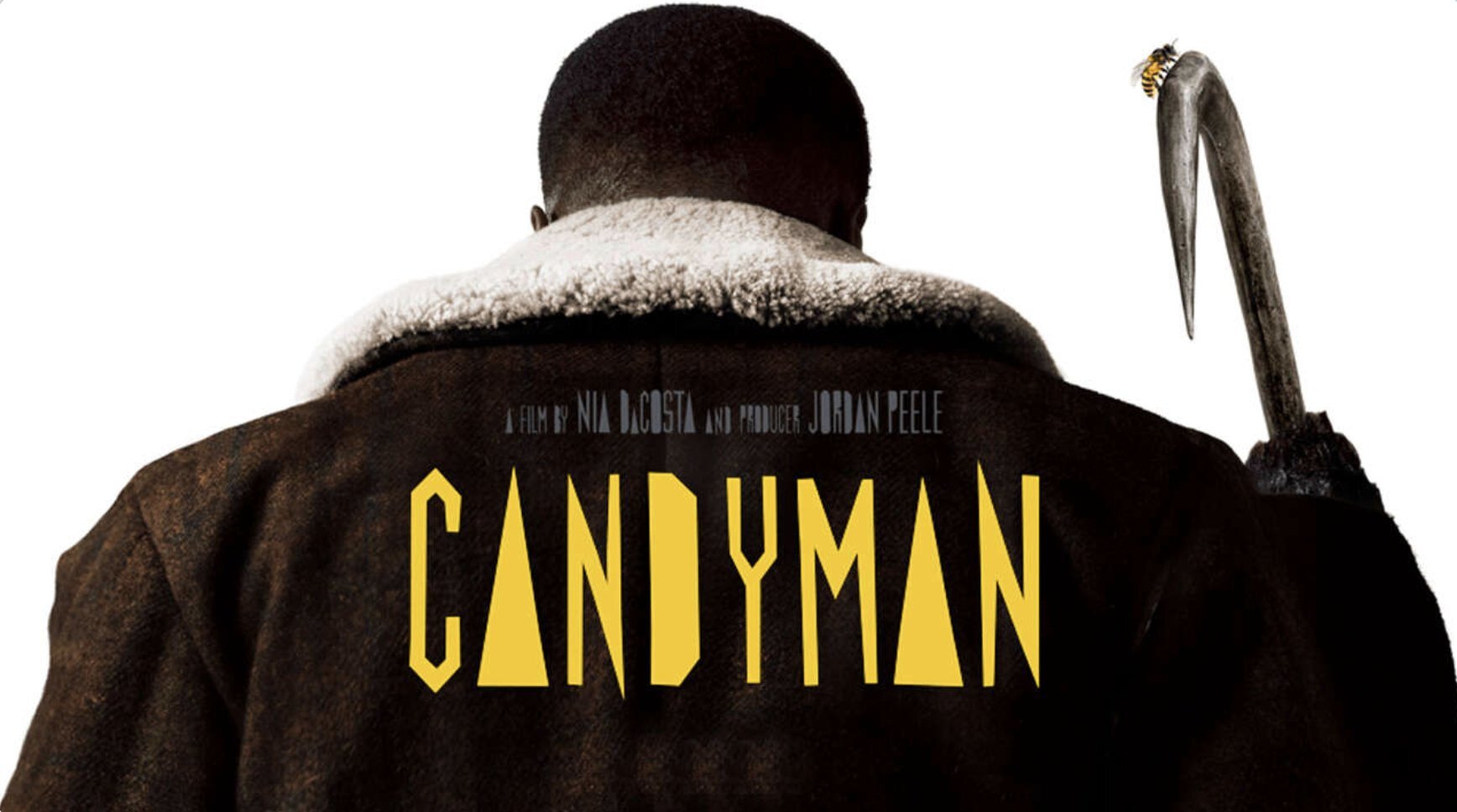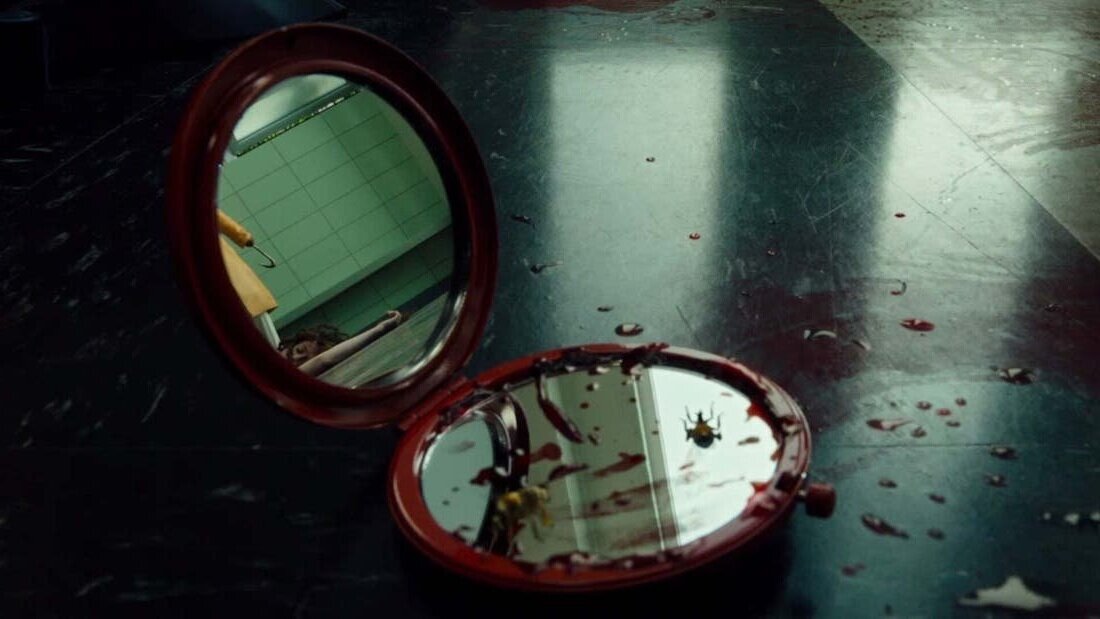Candyman (2021)

This inventive horror film works as both a belated sequel to 1992’s original Candyman, and as a standalone film in its own right. Offering visceral thrills, topical social commentary and a fresh perspective on the material, it’s just as creative and engaging as the original cult classic.
Premise: When a struggling artist (Yahya Abdul-Mateen II) and his art gallery curator girlfriend (Teyonah Parris) move into a new apartment in the recently gentrified Cabrini-Green area of Chicago, they hear about the urban legend of Helen Lyle, who went on a killing spree there 30 years ago after becoming obsessed with the so-called “Candyman”.
Review:
As this is a non-spoiler review, I’m going to stay clear of one piece of key information that may or may not be considered a “spoiler”. There is a piece of information that is given relatively early on in the film (suggesting that it isn’t considered a “spoiler”), but it’s only going to mean anything to viewers who remember the original Candyman from 1992. As the relevance of that information is not revealed to either the characters in the film or to the (new) audience members until later in the film, I’m going to consider the revelation to be a “spoiler” that I won’t give away here.
This spoiler/non-spoiler debate is, ironically, a side effect of that fact that this movie works seamlessly as both a standalone film (for people who haven’t seen the original) and a sequel to the 1992 cult classic that interweaves expertly with that first film (and which ignores the two lesser sequels from 1995 and 1999). Everything you need to know about the events of the first film, in which Helen Lyle (Virginia Madsen) was framed for the murders committed by the Candyman, is set out for new viewers, while fans of the original film will find plenty of enjoyable easter eggs and call-backs throughout this sequel.
“…this sequel has not lost any of the first film’s poignancy…”
The first Candyman film is sometimes unfairly remembered as just another of the “slasher-horrors” from the 80/90s, but it was so much more than that. Right from the start, it was an exploration of the power of urban legends on the collective consciousness of local communities, and the story of the brutal, racially-motivated murder of Daniel Robitaille (Tony Todd) set the film aside from any of the other horror films of its era.
This 2021 sequel has not lost any of the first film’s poignancy, and in fact, the racial commentary is even more explicit (but without ever overshadowing the film’s other elements). The 1992 original was written and directed by a White man (Bernard Rose) and was told from the perspective of a middle-class White woman (played by Virginia Madsen) - whereas the 2021 sequel is co-written by Jordan Peele, directed by Nia DaCosta (who is now the first Black woman to have directed a number one film at the box office), and told from the viewpoint of two Black characters. This in itself would have given the film a very different perspective from the first film, but there is also added social commentary on the gentrification of predominant Black neighbourhoods, as well as the circumstances which gave rise to such ghettos in the first place.
“…explores how the Candyman legend came to personify Black injustice at the hands of White society…”
This racial subtext was arguably what set the original Candyman apart from the other horror films of its time, but the 2021 sequel takes these concepts to even more interesting places. It expands on the themes in the first film, such as the fact that over the years other people have (intentionally or unintentionally) become caught up in the urban legend of the Candyman, as well as the power that belief in an urban legend can have within a community. And whereas in the first film Helen Lyle’s theory was that the Candyman legend had become a way of coping with the daily hardships in the Cabrini-Green projects, in the sequel, Colman Domingo plays William Burke, a character who grew up in Cabrini-Green in the 70s and who witnessed first-hand how the Candyman legend came to personify Black injustice at the hands of White society.
All of which could make the film sound like it’s hard work, but like with Get Out and Us, co-writer Jordan Peele (along with Nia DaCosta and Win Rosenfeld) skilfully blends the social commentary with visceral thrills, and even a vein of black humour. So while the social commentary adds an extra dimension to what is in effect a ghost story, the film in no way skimps on the blood and gore when it matters.
“…Nia DaCosta’s direction elevates every scene…”
That said, I also wanted to specifically mention Nia DaCosta’s direction, which I felt truly elevated every scene. When violence does erupt, Nia DaCosta finds interesting and inventive ways to frame the action, so that you’re never presented with a straightforward, workmanlike depiction of the attacks. Elsewhere, the use of shadow puppetry for flashback scenes adds to the sense of visual creativity, while also reinforcing that the central theme of the film is the power of storytelling in its various forms. Equally, as the story focuses very heavily on mirrors (the legend being that saying Candyman’s name in a mirror five times will summon his spirit), Nia DaCosta incorporates reflections and reflective surfaces into almost every scene, so that sometimes you’re not even sure if you’re watching the “actual” action or its reflection.
Nia DaCosta also knows how to play up the horror elements and generate tension perfectly, but without ever having to use cheap tricks. I’m personally not a fan of horror films that rely too heavily on jump-scares (anyone can make someone jump with a loud noise and sudden movement), but Nia DaCosta’s direction is much more subtle than that, showing little glimpses of danger in the edge of the frame or in a reflection, so that you’re always unnerved by what catches the corner of your eye. The fact that Nia DaCosta has just been announced as the director of the upcoming MCU film The Marvels has me very excited to see what she’ll do on that canvas.
“…an engaging supernatural ghost story that swaps the traditional gothic settings for the gentrified projects of Chicago…”
Yahya Abdul-Mateen II is great in the lead role, as is Teyonah Parris who is arguably the audience surrogate in the movie. The film also brings back Vanessa Williams as her character from the 1992 original, which further strengthens the connections between the two films. Michael Hargrove also makes an unsettling impression in a supporting role as a character from the 70s who was unintentionally caught up in the cycles of violence surrounding the Candyman urban legend.
Ultimately, the 2021 Candyman is an engaging supernatural ghost story that swaps the more traditional gothic settings for the gentrified projects of Chicago, and still manages to deliver the tension and gore that you might expect from a modern horror film. But what really sets it side is its added layer of social commentary, which is perfectly encapsulated in a frighteningly topical final act.







